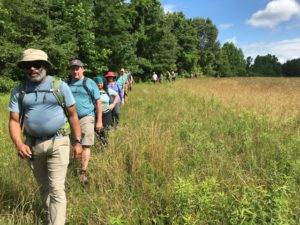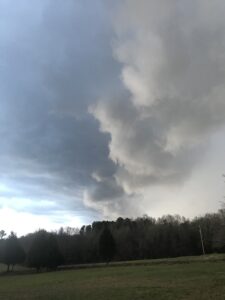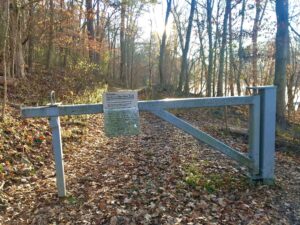I’ve been leading hikes and backpack trips for more than a decade, and it didn’t take long for me to realize that most of my hikers were older than I’d expected. We’d have a few people in their 20s, then a big gap, then a whole lot of people in their 50s. And 60s. And 70s. It eventually dawned on me why: people in their 20s have fewer commitments and more time to play. Same with people who are done raising kids and are reaching retirement age.
What has taken me a while to figure out is that more of the 50+ crowd might be interested in hiking if there was a supportive environment to help them get started. An environment where they could hike with others, where they could learn the local trails, where a patient, experienced hiker could share their expertise and make them feel more comfortable on the trail.
That’s why we’ve launched GetHiking! 50+, a hiking program aimed at folks emerging from decades spent taking care of others — at home, at work — and now are looking for something challenging and meaningful to do for themselves. Something they can continue doing for another 20 or 30 years, or more.
Today, we share 10 bits of advice on how to get into this hiking thing if you’re age 50 or older — or simply if you haven’t hiked in a while, if ever. At the end of today’s post we share two hiking programs we’re launching aimed at helping you find your place, and your pace, on the trail.
I’m glad you’re here. Welcome to the trail!
1. Use trekking poles. I start this list with trekking poles because they can cure so many ills. Got balance issues? Trekking poles are great at keeping you upright, especially over iffy terrain and water crossings. Trick knee? Proper use of poles can take a surprising amount of pressure off your knees, up to 25 percent, according to outdoorgearlab.com. Unsteady on steep downhills? Poles act as breaks to ease your descent. Need a little boost going uphill? Let your pole-toting arms pitch in and assume some of the work. Trekking poles are such a plus, there’s no reason for anyone, especially a 50+ hiker, not to use them.

2. Don’t hike alone. For me, this is a Do-as-I say,-not-as-I-do suggestion. I hike alone largely because my hikes tend to be either spontaneous or with a goal in mind — scouting, for instance — that others might find distracting. But when I do hike alone I always try to do so at a time when other hikers are likely to be around. The reason? Anything can happen on the trail, to anyone. The problem when you’re older is that “anything” can result in more severe consequences. A twisted ankle can be much harder to hobble out on. Getting dehydrated can quickly become life-threatening. Heart issues, stroke, a litany of medical situations that, if not treated quickly, are exacerbated tenfold. Don’t hike alone, and don’t hike without a reliable communications device: a cell phone where you’re positive you can get a signal, and when you’re not, a GPS emergency locator such as a Spot, Zoleo, or a Garmin InReach.
3. Hydrate. You sweat when you hike, but then you probably knew that. But did you know that older adults are more likely to become dehydrated than younger hikers? There are a number of reasons for this, according to the National Council on Aging, including the fact that thirst tends to diminish with age, changes in body chemistry leave seniors with less fluid in their bodies, and seniors are more likely to take medications that increase dehydration risk. So a pursuit that already sucks the fluids out of our bodies becomes a bit more problematic for older hikers. Symptoms to watch for: fatigue, irritability, headache and cramps, among others. According to the NCO you should take a third of your body weight and drink that many ounces of fluid a day. So if you weigh 180 pounds, you should drink about 60 ounces of water daily — and that’s under normal circumstances! Don’t forget to factor in your perspiration rate on the trail. The best way to ensure that you drink while hiking? Use a hydration bladder, such as a Camelbak.
4. Eat! Just as older adults are less inclined to hydrate, they’re less inclined to eat as well. And that’s trouble, especially on the trail. Hiking burns a boatload of calories. According to one calorie calculator, a 175-pound person hiking 5 miles in 2 hours in piedmont-like terrain burns about 865 calories in that 2-hour stretch (according to the U.S. Department of Health and Human Services, the typical adult woman burns between 1,600 and 2,400 calories per day, the typical male between 2,000 and 3,000). So, what to eat on the trail? Whatever you’re inclined to eat, provided it has good nutritional value and provides the fuel you need to keep from bonking. Nuts and seeds are popular trail foods (high in protein), cheese as well.
5. Use sunscreen. Granted, the bulk of the damage to your skin from exposure to the sun occurs in your youth (23 percent of the damage is done by the time you’re 18, according to the American Society for Photobiology). Still, even though damage may already have been done, your thinner skin (literally!) makes it even more susceptible to the harmful UV rays of the sun. It’s imperative that you protect you skin when you venture out. The American Academy of Dermatology recommends using sunscreen that offers broad-spectrum protection (against both ultraviolet A and B rays), with an SPF of 30 or higher, and one that’s water resistant). Improve your degree of protection by wearing clothing with UV protection, as well as a wide-brim hat (I like a sombrero).
 6. Be vigilant about the weather. Most of us have a tale from our youth about getting caught in severe weather and emerging unscathed (physically, if not emotionally). I’ve got several, including once being caught on a bike ride in eastern Colorado by a hail storm that beat the crap out of me and dropped the temperature by a good 25 degrees. I hobbled 20 miles home and sat in a warm tub for a half hour to stop shivering. My 17-year-old body quickly recovered. That wouldn’t be the case with a body with a half century of wear. Not only is it uncomfortable being caught unprepared in, say, an afternoon thunderstorm, it can be deadly. Check the weather starting three days before heading out and then, just before you hit the trail. Pack accordingly, including clothes and food — or delay your adventure altogether.
6. Be vigilant about the weather. Most of us have a tale from our youth about getting caught in severe weather and emerging unscathed (physically, if not emotionally). I’ve got several, including once being caught on a bike ride in eastern Colorado by a hail storm that beat the crap out of me and dropped the temperature by a good 25 degrees. I hobbled 20 miles home and sat in a warm tub for a half hour to stop shivering. My 17-year-old body quickly recovered. That wouldn’t be the case with a body with a half century of wear. Not only is it uncomfortable being caught unprepared in, say, an afternoon thunderstorm, it can be deadly. Check the weather starting three days before heading out and then, just before you hit the trail. Pack accordingly, including clothes and food — or delay your adventure altogether.
7. Make sure you’re physically prepared. Gone are the days when you could head out on a lark and hike 5 miles having not been active for a month or three. When you’re young, your body can put up with a lot — it also can recover more quickly from your ill-conceived adventures. As an older hiker, you put yourself at undue risk when you ask your body to do things it’s not prepared for. For instance, if you’re interested in hiking with a group that does 3-mile hikes every Friday morning (see below), first, make sure you can hike 3 miles. Also find out the kinds of trails the group hikes. Are they paved greenway trails through flood plains? Or are they natural surface hikes, maybe with some rocks and tree roots thrown in, on rolling terrain? There’s a big difference. The main reason to be prepared? You’ll simply have a lot more fun if you aren’t struggling to make it to the end.
8. Pay attention to your medications. If you’re on medications, check with your physician or pharmacist before increasing your activity level, especially before venturing into the remote woods on a strenuous hike. For instance, OldGeezerHiking.com says if you’re on diuretics, or on a medication that includes diuretics, you’re at a much greater risk for dehydration. Check and see what other issues could result from the medications you’re on. And, harkening back to Tip No. 2, make sure the people you are hiking with are aware of any meds you might be on. Four years ago I was leading a hike where one of the hikers simply stopped, sat against a rock and stared. She was near comatose and unable to communicate, making it impossible to find out what was wrong. We had no choice but to call in a rescue and carry her out. Turned out she had just changed medications for a condition she was being treated for and the new meds didn’t mix well with strenuous exercise. Had we known, we could have contacted her physician for an appropriate course of action.
 9. Think twice about “going under the rope.” “Under the rope,” that’s actually a ski term about skiing terrain that’s closed — and indicated as such by a rope. In the case of hiking, going under the rope would be hiking off trail. Now, I love going off trail, and have been leading Winter Wild off-trail adventures for years. But those off-trail adventures are carefully scouted with few surprises of the unfortunate kind. And, I’ve researched Plan Bs and exit options. That’s a far-cry from seeing an old roadbed striking out from the trail and thinking, “Shucks, I’ll just see where this heads.” Maybe not a terrible idea if you’ve come equipped to spend a night in the woods, but really, overall a terrible idea. Only go with someone who knows the terrain.
9. Think twice about “going under the rope.” “Under the rope,” that’s actually a ski term about skiing terrain that’s closed — and indicated as such by a rope. In the case of hiking, going under the rope would be hiking off trail. Now, I love going off trail, and have been leading Winter Wild off-trail adventures for years. But those off-trail adventures are carefully scouted with few surprises of the unfortunate kind. And, I’ve researched Plan Bs and exit options. That’s a far-cry from seeing an old roadbed striking out from the trail and thinking, “Shucks, I’ll just see where this heads.” Maybe not a terrible idea if you’ve come equipped to spend a night in the woods, but really, overall a terrible idea. Only go with someone who knows the terrain.
10. Listen to your body. Probably the most important bit of advice, especially as we head into the heat of summer. If you’e body is telling you to slow down, slow down. If it’s telling you to stop, stop. Feel a cramp coming on? Don’t “walk it out,” stop and drink some water, something with electrolytes ideally, better still take a potassium tablet or eat a banana. Starting to sweat a little too much? Find yourself short of breath? Suddenly a little dizzy? All signs to stop, sit in the shade and take a minute to figure out what’s going on and how to nip it in the bud.
* * *
Explore with Us!
Ready to get started? We have two summer hiking programs ideal for both the beginning hiker and for experienced hikers who don’t want to stop hiking because it’s summer, but don’t want to wear themselves out, either. Hikes in both series are between 3 and 4 miles, last about an hour and a half, and explore a new trail each week.
- GetHiking! 50+ Friday Morning Summer Hike Series, 8 hikes at 8 a.m. on Fridays, on trails in the western Triangle. More info here.
- GetHiking! 50+ Wednesday Evening Summer Hike Series, 10 hikes at 6:30 p.m. on Wednesdays. Popsicles conclude each outing. More info here for single hikers, here for couples and families.
Hike ’til you’re … 200?
 This week on the GetHiking Southeast Podcast we talk with Jerry Kroll, founder of Jevitty Life Science, which is working to use existing and emerging technology — coupled with good lifestyle habits — to extend our lives significantly. Give a listen here.
This week on the GetHiking Southeast Podcast we talk with Jerry Kroll, founder of Jevitty Life Science, which is working to use existing and emerging technology — coupled with good lifestyle habits — to extend our lives significantly. Give a listen here.
Learn more
For more information on topics touched on today:
- “21 Simple Survival Tips for Hikers Over 50.” These tips come from oldgeezerhiking.com, and cover a range of appropriate suggestions. Learn more here.
- “How to Stay Hydrated for Better Health,” a blog post from the National Council on Aging that goes deeper into the importance of staying hydrated for older adults. Check it out here.
- Skin Care and Aging. Learn more about the importance of protecting your skin in this post from the National Institute on Aging.
